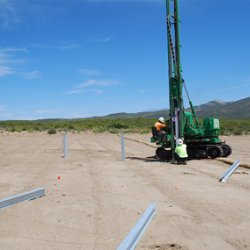GRID Alternatives Inland Empire (GRID IE) recently broke ground on its largest community-scale solar project to date. Earlier this year, GRID IE was awarded a $2.05 million grant by the California Department of Community Services and Development (CSD) Low-income Weatherization Program, Community Solar Pilot Program. The CSD Santa Rosa Community Solar Project is part of the California Climate Investments, a statewide initiative that puts billions of Cap-and-Trade dollars to work reducing greenhouse gas emissions, strengthening the economy, and improving public health and the environment — particularly in disadvantaged communities. The nearly 1-megawatt solar electric system on the Santa Rosa Band of Cahuilla Indians reservation — California’s first low-income community solar project — will provide $5.4 million in savings to benefit low-income members of Anza Electrical Cooperative (AEC). AEC will offer bill credits to qualified low-income residents, enabling low income co-op members to significantly reduce their energy bills. They will also maintain full ownership and responsibility of the solar array and its output. AEC is slated to do some electrical upgrades including installation of new power poles and transformers to support the influx of energy.
According to the agreement with AEC, approximately 38 qualified low-income Santa Rosa Band of Cahuilla Indian Tribal members and an additional 150-250 low-income AEC members within the boundaries of the cooperative will receive a credit offsetting their electric bills.
“We are excited to break ground on California’s first low-income community solar project. The partnership between the Santa Rosa Band of Cahuilla Indians, Anza Electric Cooperative and GRID Alternatives will provide clean energy, job training and bill savings to tribal members and the surrounding community who are not currently able to benefit from existing low-income solar programs. This is what makes this pilot community solar program so special, and we hope our success will provide a model for more community solar across California,” said GRID IE Executive Director Jaime Alonso.
The first phase of the project included site grading/clearing, erosion control, surveying and location staking, receiving of piles and some racking materials, and pile driving. The second week of this phase will include continuation of pile driving, trenching, AC/DC sub work, receiving more equipment and materials and a site walk through to assess the progress. According to Commercial Project Manager Vanessa Lorrah, the project is expected to be complete in fall of 2020.
GRID’s Tribal Program helps tribal communities become self-sustaining by providing resources to assist with their clean energy goals. For more information about GRID Alternatives Inland Empire, visit www.gridalternatives.org/ie or call 951-272-GRID(4743).
ABOUT CSD
The Department of Community Services and Development’s (CSD’s) Low-Income Weatherization Program Community Solar Pilot is part of California Climate Investments, a statewide initiative that puts billions of Cap-and-Trade dollars to work reducing greenhouse gas emissions, strengthening the economy, and improving public health and the environment — particularly in disadvantaged communities. CSD partners with non-profit organizations and local governments dedicated to helping low-income individuals and families achieve and maintain economic security, meet their home energy needs, and reduce their utility costs through energy efficiency upgrades and access to clean renewable energy.

